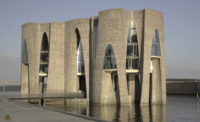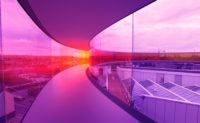Final designs for the Serpentine Gallery’s annual summertime pavilion were unveiled in London yesterday. After a last-minute decision to postpone the German architect Frei Otto’s scheme, the gallery gave Norwegian architect Kjetil Thorsen, co-founder of Snøhetta, and the Danish-Icelandic artist Olafur Eliasson a joint creative role. The duo created a top-like, spinning form clad in plywood with a steel structure flanked by a double-layer curved skin of teeth-like white baffles.
At a press conference on Wednesday, Eliasson said that their design takes its cue from “the dynamics of movement, exploring vertical circulation in a single space.” He added that it is intended “not to be about decoration but the interaction of people as they journey through the space.”
Visitors will enter the 50-foot-high pavilion via a spiralling helical ramp. On its ascent, the ramp curves upward into the outer wall in one form, taking visitors to the roof; there, an oculus will let daylight into the interior and provide a bird’s eye view of the space below as well as panoramic views of a park that surrounds the gallery. The upper roof cantilevers over an interior void.
“The program is now in its eighth year and we’ve been looking at how we can develop the project so it stays fresh,” said Julia Peyton-Jones, the Serpentine’s director, explaining the gallery’s decision to give Eliasson a substantial design role with Thorsen. Since the 1990s, she added, his work has “explored a new dynamic of what architecture could be.”
For his part, Eliasson said that he would conduct experiments with people inside the pavilion. These might include adding vibrational qualities to the building that would make it resonate like a musical instrument, and experiments with food and light. His Berlin-based studio researches the relationship between people and their surroundings and the impact of light conditions that the pavilion aims to reflect.
The Serpentine’s temporary summertime pavilion, which opens in July, attracts an average of 250,000 visitors. In the past it has featured designs by Rem Koolhaas, Alvaro Siza and Eduardo Souto de Moura, Oscar Niemeyer, Toyo Ito, Daniel Libeskind, and Zaha Hadid. As it has before, Arup will engineer the pavilion.








